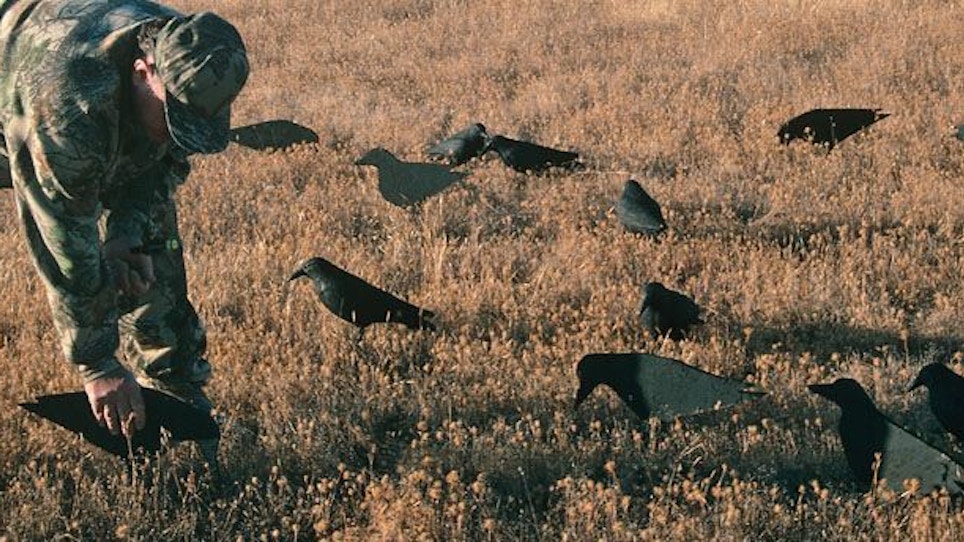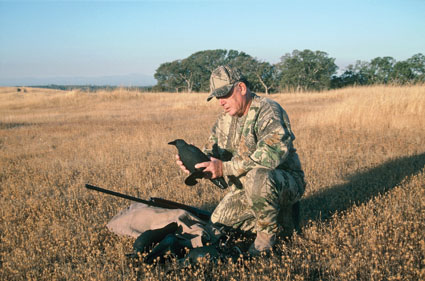 The American Crow is found in every state in this nation and its numbers have never been threatened by the presence of man or hunting. In fact, humans have helped expand their numbers and range. From the Pacific Ocean to the eastern seaboard, from Canada down to Mexico, the big birds soar through all skies. Numbers have been estimated to be about 31 million, but this is only an estimate. I’ve found them in western deserts where a jackrabbit has a hard time making a living, to high-mountain timber and snow-capped peaks. They’re equally at home every place in between. Crows are far and away, the most under hunted game bird on the continent, a situation needing remedy.
The American Crow is found in every state in this nation and its numbers have never been threatened by the presence of man or hunting. In fact, humans have helped expand their numbers and range. From the Pacific Ocean to the eastern seaboard, from Canada down to Mexico, the big birds soar through all skies. Numbers have been estimated to be about 31 million, but this is only an estimate. I’ve found them in western deserts where a jackrabbit has a hard time making a living, to high-mountain timber and snow-capped peaks. They’re equally at home every place in between. Crows are far and away, the most under hunted game bird on the continent, a situation needing remedy.
Crows can legally be hunted in just about every state, but seasons and bag limits vary. For example, Kentucky has no limit on the number of crows that can be taken, but does have a split fall season much like those used for waterfowl. Ohio has no daily bag limit with a season that runs from March to June. Nevada has a statewide limit of 10 birds per day during a split fall and spring season. California allows 24 birds per day with a season that opens in early December then runs 124 days consecutively. In New York there is no limit and no season. The lesson here is to carefully check your state game department regulations on migratory game birds.
When to Hunt
Wherever you find and hunt crows their daily timing is very much the same. Only sudden changes in weather sometimes interrupt normal routines. The birds are early risers. They fly from their nighttime roosts at dawn in groups of 50 to 100 birds. As they move away they fan out into smaller groups, each going their own way searching for feeding opportunities. This is when they are most vulnerable, whether you pass shoot or decoy them.
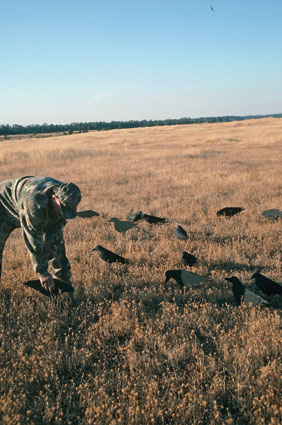 As the morning advances these numbers diminish further into just groups of two, three, or four birds freelancing over wide areas. Crows are not only intelligent, but very gregarious, social birds. They like the company of their own kind and are endlessly curious about what other crows are doing or feeding on. These traits are what endear them to hunters and can be capitalized on. As a test I’ve set up four or five crow decoys on my front lawn while vehicle traffic drove by only yards away, then watched crows come spiraling down to land to see what their pals were up to.
As the morning advances these numbers diminish further into just groups of two, three, or four birds freelancing over wide areas. Crows are not only intelligent, but very gregarious, social birds. They like the company of their own kind and are endlessly curious about what other crows are doing or feeding on. These traits are what endear them to hunters and can be capitalized on. As a test I’ve set up four or five crow decoys on my front lawn while vehicle traffic drove by only yards away, then watched crows come spiraling down to land to see what their pals were up to.
During mid-day hours they’ve learned to course rivers where dead fish might be found during spawning season, or hit farmlands when the harvest is in full swing because of scattered grains and the stirring up of insects or small animals by machinery. Crows have even timed their arrival at fast food joints, looking for garbage and scraps of food. If you’ve ever watched a crow unwrap a half eaten Big Mac, you know what I mean.
The birds will eat anything they can get their beak over – bugs, insects, frogs, mice, the eggs of other birds, grains, seeds, nuts, and Big Macs. Nothing is more fascinating than watching a crow with a nut too hard to open by its beak. They fly over roads or concrete and drop the nut, cracking it open on impact. Crows routinely patrol the berms of roads and highways at dawn looking for animals killed by overnight traffic. That’s how smart and determined they are, and the reason they’re so successful as a species.
Hunting with Decoys
You can pass shoot crows once you determine their daily flight paths and at what time they move along them. However, using decoys to lure them in is the most thrilling aspect of all. Because of their natural inquisitiveness and curious nature, a life-like spread of decoys is key to exciting shooting. It does not take as many decoys as duck or goose hunting. Twelve decoys can work wonders if done correctly.
Choose set-up locations where you’ve seen crows passing or feeding previously. Stake your decoys in the open, in low ground cover where they’re easiest to see by in-flight birds. There is no single best place to do this. It might be riparian weed fields, harvested crops, around fruit or nut orchards, along waterways, anyplace crows regularly travel and feed.
I space decoys three or four feet apart. Don’t get fancy with special patterns or designs. Keep them all in one cohesive group, but facing different directions, like birds foraging. A natural blind of some kind should be situated about 30 yards away. Dressing in full camo clothing, including a camo facemask is essential. Not only are these birds smart, but they are wary and have excellent vision, causing them to shy away from the smallest detail left uncovered.
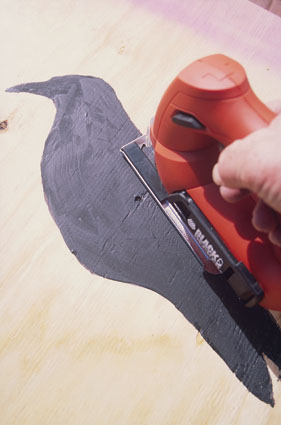 Crow decoys can be purchased or ordered at local sport shops or catalog stores such as Cabela’s. There are several types of decoys available. There are ground decoys, decoys that hang from limbs, and spinning-wing decoys that are either battery or wind powered. The decoy that hangs from a limb is used to mimic new birds that just landed and a sentry bird looking over its pals feeding below.
Crow decoys can be purchased or ordered at local sport shops or catalog stores such as Cabela’s. There are several types of decoys available. There are ground decoys, decoys that hang from limbs, and spinning-wing decoys that are either battery or wind powered. The decoy that hangs from a limb is used to mimic new birds that just landed and a sentry bird looking over its pals feeding below.
Another effective addition is either an owl or hawk decoy set nearby, generally on a tree limb where it can be easily seen. Owls and hawks are the crow’s deadliest enemies. Crows will swoop in to attack and protect others of their kind, adding another layer of realism to your set up.
Crow Calling
Calling crows into decoys is a fascinating exercise, and as big a thrill as calling in ducks or geese. It’s easily learned, but you must use the right calls at the right time. The wrong tempo or sour note can turn the birds away quickly. The best way to match natural calling is by going out, watching and listening to live birds. See what they’re doing and what calls they make while doing it.
It’s been written that crows have a vocabulary of at least 25 words. I don’t doubt it, but you need not learn all 25 to be successful. Many brands of crow calls are on the market, but no two produce exactly the same sound, pitch, or volume. I use at least two and sometimes three. Some are soft, another louder, a third more raspy. Learning three basic calls is all any crow hunter needs.
When you have crows at a distance and want to get their attention, you must blow an “Over Here” call, which is the loudest in volume. This comes out as the standard “Caw” everyone associates with these birds, but delivered as three single notes spaced two to three seconds apart. It sounds like this. “CAW---CAW---CAW.” If you blow this same loud sequence without the spacing, running them quickly together, you’ve just mimicked the crow’s alarm call and will send them packing in the opposite direction. Proper tempo and volume are important.
As birds come closer and spot your decoys, switch to a somewhat softer “Welcome” call. This is a two note delivery with emphasis on the first higher note, tapering off to a raspy, shorter one. It sounds like this. “Caw-cawww. Caw-cawww.” Continue this until you’re certain the birds are committed to investigating your spread and coming.
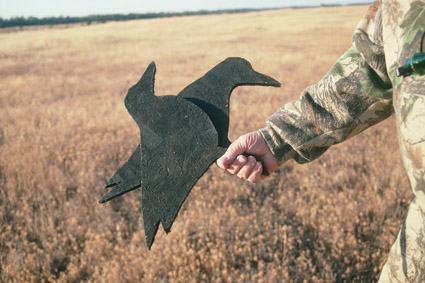 For a final “All’s Well” convincer just before birds enter shotgun range, switch to a low, raspy, drawn out one note call made by vibrating the call reed with just enough air to produce a contented sound. It comes out as a, “brrrrrrrrr---brrrrrrr---brrrrrr.” On all calls you must learn to force air from your diaphragm, just as you would a predator call, and not by puffing your checks or blowing by exhaling from your lungs. This gives you better control, and the ability to switch to a quicker pitch change.
For a final “All’s Well” convincer just before birds enter shotgun range, switch to a low, raspy, drawn out one note call made by vibrating the call reed with just enough air to produce a contented sound. It comes out as a, “brrrrrrrrr---brrrrrrr---brrrrrr.” On all calls you must learn to force air from your diaphragm, just as you would a predator call, and not by puffing your checks or blowing by exhaling from your lungs. This gives you better control, and the ability to switch to a quicker pitch change.
Guns and Ammo
Crows seem large in the air because of wingspan, color and feathers. But they are actually lightly built and about 70 percent feathers. A plucked crow looks like they’ve been on a starvation diet even when they’re eating well. Your choice of shotguns should be the same you would use for dove, quail, grouse, pheasants or waterfowl. Semi-automatic, pump gun, or over/under makes little difference. My only exception would be a single shot because it limits follow up shots.
Personally, I would add this limitation: I shoot a pair of lovely 20-gauge shotguns. One is an over/under, the other a side by side. A 20-gauge is enough gun for crows with this stipulation. I use mine over decoys at or under 35 yards. I also use a three-inch, high brass shell loaded with No. 7 1/2 shot for this work. You can buy and use standard “target loads” or what is sometimes termed light loads if you stick strictly to decoy range shooting with a modified choke. I simply like the extra punch and pellet increase in the three-inch shell if I find I have to shoot slightly farther.
I don’t think a 20-gauge is ideal for pass shooting, even though you might drop a bird beyond 35 yards. For that, I pick up my 12-gauge autoloader. For decoy range, low brass shells in No. 7 1/2 work fine with a modified choke. However, if you’re pass shooting at birds in the 40-, 45- to possibly 50-yard range, or if you choose not to use decoys, use a high brass No. 6 shot out of a full choke.
Go out and have fun hunting, calling, and decoying the American crow. He’s available when other seasons have closed, and in numbers our grandfathers saw nearly a century ago. Winged predator hunting simply doesn’t get any better than this!
